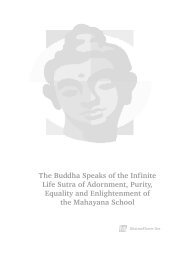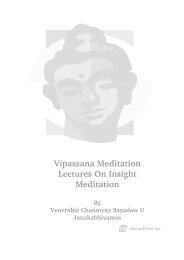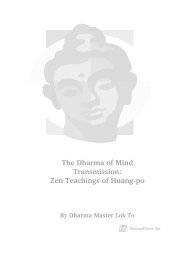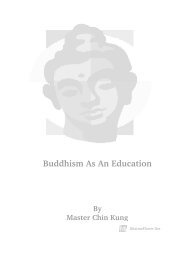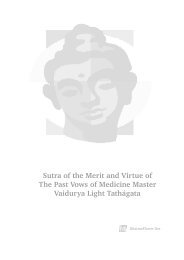THE FOUR NOBLE TRUTHS By Ajahn Sumedho - DharmaFlower.Net
THE FOUR NOBLE TRUTHS By Ajahn Sumedho - DharmaFlower.Net
THE FOUR NOBLE TRUTHS By Ajahn Sumedho - DharmaFlower.Net
Create successful ePaper yourself
Turn your PDF publications into a flip-book with our unique Google optimized e-Paper software.
een living the Holy Life for a long time so I must be better than any ofyou!’ Where does THAT arise and cease?When there is arrogance, conceit or self-disparagement - whatever it is- examine it; listen inwardly; ‘I am....’ Be aware and attentive to thespace before you think it; then think it and notice the space thatfollows. Sustain your attention on that emptiness at the end and seehow long you can hold your attention on it. See if you can hear a kindof ringing sound in the mind, the sound of silence, the primordialsound. When you concentrate your attention on that, you can reflect:‘Is there any sense of self?’ You see that when you’re really empty -when there’s just clarity, alertness and attention - there’s no self.There’s no sense of me and mine. So, I go to that empty state and Icontemplate Dhamma: I think, ‘This is just as it is. This body here isjust this way.’ I can give it a name or not but right now, it’s just thisway. It’s not <strong>Sumedho</strong>!There’s no Buddhist monk in the emptiness. ‘Buddhist monk’ ismerely a convention, appropriate to time and place. When peoplepraise you and say, ‘How wonderful’, you can know it as someonegiving praise without taking it personally. You know there’s noBuddhist monk there; it’s just Suchness. It’s just this way. If I wantAmaravati to be a successful place and it is a great success, I’mhappy. But if it all fails, if no one is interested, we can’t pay theelectricity bill and everything falls apart - failure! But really, there’s noAmaravati. The idea of a person who is a Buddhist monk or a placecalled Amaravati - these are only conventions, not ultimate realities.Right now it’s just this way, just the way it’s supposed to be. Onedoesn’t carry the burden of such a place on one’s shoulders becauseone sees it as it really is and there’s no person to be involved in it.Whether it succeeds or fails is no longer important in the same way.In emptiness, things are just what they are. When we are aware inthis way, it doesn’t mean that we are indifferent to success or failureand that we don’t bother to do anything. We can apply ourselves. Weknow what we can do; we know what has to be done and we can do itin the right way. Then everything becomes Dhamma, the way it is. Wedo things because that is the right thing to be doing at this time andin this place rather than out of a sense of personal ambition or fear offailure.The path to the cessation of suffering is the path of perfection.Perfection can be a rather daunting word because we feel veryimperfect. As personalities, we wonder how we can dare to evenentertain the possibility of being perfect. Human perfection issomething no one ever talks about; it doesn’t seem at all possible tothink of perfection in regard to being human. But an arahant issimply a human being who has perfected life, someone who haslearned everything there is to learn through the basic law: ‘All that issubject to arising is subject to ceasing.’ An arahant does not need to



